Introduction
Dental caries characterized by cavitation of the enamel and penetration of microorganisms into the dentine is caused by disequilibrium in the process of demineralization of hard tissues induced by the proliferation of cariogenic bacteria and consequent increase in acid production, causing the saliva pH to drop to a critical level [1]. Takao Fusayama in 1980 distinguished two layers in caries lesions the first layer “outer carious dentine” is highly infected, acidic, demineralised, not sensitive to contact, can be removed without anaesthesia and fail to remineralize in a natural way and the second layer “inner carious dentine” is partially demineralised and slightly infected, but the collagen fibrils retained their natural structure around intact dentinal tubules. Because of this remaining structural integrity, the inner carious dentine was sensitive to removal without anaesthesia [2].
Presently, there is increasing move towards less invasive treatment and preventive dentistry in the current odontologic era [3]. Conventional caries removal and cavity preparation entail the use of burs on a high-speed handpiece to gain access to the carious lesion, and a low-speed handpiece to remove carious dentine [4]. Steel bur excavation and Conventional rotary techniques removes largest amount of sound tissue (over-preparation) leaving behind some amount of carious tissues (under-preparation) with the possibility of overextending the cavity, healthy tissue removal, pressure and heat on the pulp, vibration, noise, pain stimulus and the need of local anaesthetic, a procedure that causes aversion in many patients, especially children [5].
Recently Boston in 2003 developed a possible alternative to conventional methods of dentine caries removal by introducing a new Polymer prototype bur. Self limiting polymer burs, the new version of SmartPrep™, the now called SmartBurs™ (SS White, Lakewood, N.J., USA) with reinforced blades have been introduced that is used with a slow-speed handpiece and intended to selectively excavate carious degraded dentine. These Polymer Burs presented the smallest area of over-preparation and the largest area of under-preparation [6,7].
Chemomechanical caries removal technique is another non-invasive hand excavation method which removes only the infected dentine maintaining the demineralised portion for repair and remineralization [8]. Habib et al., used Sodium hypochlorite for the removal of carious dentine [1]. Carisolv™ introduced to the European market in 1998 containing three amino acids-lysine, leucine, and glutamic acid was found to be more effective and easy to manipulate but used by few professionals due its high cost and requirement of customized instruments [9]. In 2003, a Brazilian gel was developed based on papain, chloramines, and toluidine blue called Papacarie gel (Formula & Acao, Sao Paulo, Brazil) having antibiotic, bacteriostatic, and anti-inflammatory properties enhancing its use in Special Health Care Needs (SHCN) patients and phobic adults in paediatric dentistry and public health sectors [10].
Currently, research in dentistry has concentrated its efforts on the quality of treatment given and the goal is to preserve the potentially remineralizable inner layer of the carious lesion as much as possible. As each technique entails a specific caries removal endpoint, the extent of carious dentine excavation, the time taken by each caries excavation technique needs to be evaluated including the microbiological aspect. Hence, the present in-vitro study was designed with an objective to evaluate the efficacy of caries removal using Polymer Bur, Stainless steel bur, Carisolv and Papacarie to compare the effectiveness of caries removal among all the agents used.
Materials and Methods
The present in vitro study was carried out in the Department of Pedodontics and Preventive Dentistry in association with the Department of Oral and Maxillofacial Pathology, St. Joseph Dental College, Eluru, Andhra Pradesh, India.
Experimental design
In this experiment, method of carious dentine removal is the independent variable and time (in seconds) required to remove dentine (Efficiency) and the detection of bacteria after carious removal and dentinal tubule destruction (Efficacy) are the response or dependent variables.
Sample selection
A total of 60 extracted primary molars [Table/Fig-1] were collected. The teeth included were selected based on modified caries classification of Mount and Hume given by Lasfargus et al., in which caries distribution is done according to site and stage of progression of the lesion [11]. Teeth with deep carious lesion and with pulp exposure or potential for pulp exposure are excluded. All the extracted teeth were stored in Normal Saline.
Materials used in the study [Table/Fig-2] :
1. Polymer bur (SmartPrep, SS White Burs, Inc., Lakewood, NJ, USA)
2. Stainless steel bur (S.S. White Company)
3. Carisolv™ (Mediteam, Sweden)
4. Papacarie (Formula & Acao, Sao Paulo, Brazil)
Specimen preparation
Specimens were prepared by sectioning each tooth mesiodistally in the centre of the carious lesion using diamond discs so that the two halves (buccal and lingual or palatal) having equal sized carious lesions are evaluated for four caries excavation methods.
Caries removal procedure
1. Polymer bur method: Carious tissue was removed with circular movements starting from the centre of the lesion to the periphery as recommended by the manufacturer. Excavation was stopped when the instrument became macroscopically abraded and blunted and was no longer able to remove tissue. The presence of hard tissue was also checked with a probe.
2. Stainless steel bur method: Burs were used in a slow-speed handpiece, according to the size of the lesion. Dentine excavation was stopped when hard dentine was detected using a non-flexible dental probe. Dentine was considered hard when, in applying a firm pressure the probe was not able to penetrate into dentin [12].
3. Carisolv method: Carious dentine was covered with Carisolv gel for 30 seconds and was scraped with the specially designed hand instrument to remove softened carious tissue. The procedure was repeated until the gel became clear and a sharp explorer was used to confirm that the cavity was free of caries and the remaining gel is removed with a cotton pellet soaked in water.
4. Papacarie method: Carious lesion was covered with Papacarie gel for 30 seconds and was scraped gently with a spoon excavator once the gel becomes cloudy. Removal of carious dentine was continued until the gel was no longer cloudy.
Evaluation of Efficiency (Time taken to remove caries) and Efficacy (The detection of bacteria after carious removal and Dentinal tubule destruction): The time taken was measured and recorded from start of caries removal till the cavity was confirmed to be caries free with the help of a stop.
After caries removal the specimens were stored in individual plastic containers and decalcified with 10% Formic acid [Table/Fig-3] at room temperature [13]. They were dehydrated in ascending degrees of Ethanol, cleared in Xylene and embedded in Paraffin [Table/Fig-4] and cut into 5μm sections for staining with Eosin and Hematoxylin to evaluate the presence of bacterial deposits and dentinal tubule destruction using conventional light microscope.
Results
The results were statistically evaluated. The data obtained from the four groups was subjected to following statistical analysis using One-way Analysis Of Variance (ANOVA) to determine significant differences in time taken for caries removal and Chi-square test to calculate values of bacterial deposits and dentinal tubule destruction after excavation of caries in each group.
The mean time taken for caries removal using Stainless Steel Bur, Polymer Bur, Carisolv and Papacarie was found to be 151 seconds, 344.80 seconds, 461.60 seconds and 359.60 seconds respectively. The time taken is more for Carisolv when compared with other agents and less for Stainless Steel Bur [Table/Fig-5] . A significant difference in the amount of bacterial deposits among all agents was found with Polymer Bur 29(96.7%) containing the maximum and less with the other agents after caries removal [Table/Fig-6,7,8] . Samples excavated with Stainless Steel Bur, Polymer Bur, Carisolv and Papacarie showed dentinal tubule destruction in 24 (80%), 6 (20%), 3 (10%) and 3 (10%) teeth respectively. The results are significant with Stainless Steel Bur causing more amount of dentinal tubule destruction when compared with other groups [Table/Fig-9,10].
Further inter-comparison between the groups was done using Paired t-test and Fisher’s exact-test. Significance for all statistical tests was predetermined at p<0.05. The observations made were the mean time taken for caries removal was found to be more for Carisolv when compared to others. More amount of bacterial remnants were present after excavation with Polymer Bur. Excavation with Polymer Bur, Carisolv, Papacarie is more conservative with the least amount of Dentinal tubule destruction when compared to Stainless Steel Bur [Table/Fig-11,12,13,14,15,16] .
Discussion
The conventional carious tissue removal method using high and low speed burs, allows fast treatment with unnecessary structure removal and consequent weakening of the tooth remainder, causing pulp injuries as well [6].
As an alternate to chemomechanical caries removal technique, the concept of preserving sound tooth structure showing much interest among dental researchers. This technique preserves remineralizable tissue and prevents over-excavation of the cavity [14].
The present in-vitro study was conducted with the objective to evaluate the efficacy (Bacterial remnants and Dentinal tubule destruction) and efficiency (time taken) of caries removal using Stainless Steel Bur, Polymer Bur, Carisolv containing active gel (Glutamic acid, Leucine and Lysine), fluid (Hypochlorite) effective in removing infected dentine and preserving affected dentine [15] and Papacarie containing active ingredient papain which is an specific enzyme endoprotein with bactericidal, bacteriostatic and anti-inflammatory action and chloramines as disinfectant [16,17]. The extracted teeth selected based on the modified classification of Mount and Hume proposed by Lasfargues et al., were considered as it helps minimizing differences in the excavation results due to the different extension, depth, localization and structure of the caries.
In the study, 10% Formic acid was used as dehydrating agent as it causes minimal soft tissue shrinkage and minimal loss of tissue when compared to Nitric acid which showed crumbling of tissue as reported by Zappa et al., [18].
As found in this in-vitro investigation, among the four agents the time taken for caries removal was less with Stainless Steel Bur (151 seconds) when compared to Polymer Bur (344.80 seconds), Papacarie (359.60 seconds) and Carisolv (461.60 seconds) which is similar to the studies performed by Banerjee, Kidd & Watson, Dammaschke and others, Yazici & others [19]. Carisolv needs prolonged time for excavation compared to rotary instruments which may be due to little experience and training of operators in working with it [20]. Papacarie exerts an inhibitory action on cariogenic bacteria and the time taken for removal of caries was about six minutes which is in accordance with the study conducted by Motta et al.,. Pandit et al., evaluated various methods of caries removal and reported that the time needed for caries removal using traditional method was about four to five minutes and using Carisolv was about eight minutes [1]. Hegde AM & others in their clinical evaluation reported that though chemomechanical technique is time consuming it was found to be more comfortable and is definitely superior compared to conventional technique in paediatric dentistry, provided we use a lesser technique sensitive restoration which retains in the oral cavity for longer period of time [21]. Among the four agents used, the presence of bacterial remnants after caries excavation resulted in a significant difference with 43.3% samples of Polymer bur containing more amount of bacterial deposits and least with Stainless Steel Bur accounting only 10% of the samples. This is similar to the studies reported by Scheutzel, Dammaschke & others.
Similar results were shown by El-Habashy L et al., who concluded that Papacarie is significantly more efficient in reducing the residual cariogenic bacteria in the dentin of primary teeth when compared to Carisolv [22].
In the present study, Stainless Steel bur excavation resulted in a large amount of dentinal tubule destruction which accounted for 80% of the samples when compared to that of chemomechanical methods (Carisolv and Papacarie) which accounted for only 3% of the samples each which is in accordance with the study done by Hauman and Kuzmanovic. Stainless Steel Burs tends to be a fast and rather non-conservative method for dentine caries removal as these burs present a negative rake angle which leads to a less controlled movement of the instrument through the surface with over preparation [5].
The present investigation was an in vitro study and the results may not necessarily be the same as those that would be obtained in the oral environment. Application of CMCR approach makes it feasible to the operator in providing a cost effective treatment for large populations. Therefore, more research is needed to prove the clinical reliability of these products. Long term clinical studies are required to confront or corroborate these outcomes and the quality of bonding to the affected dentine needs to be ascertained.
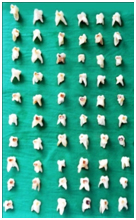
Materials used in the study
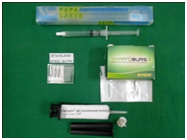
Decalcification of tooth Samples
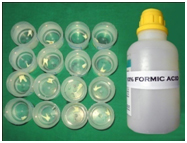
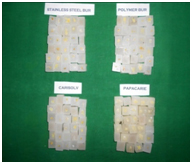
Comparison of time taken in seconds between different groupsStatistical Analysis: ANOVA one-way analysis. Statistically significant at p<0.05
| Variable | SAMPLE SIZE | MIN | MAX | MEAN± SD |
|---|
| Stainless Steel Bur | 30 | 102 | 228 | 151.00 ± 31.89 |
| Polymer Bur | 30 | 288 | 438 | 344.80 ± 35.99 |
| Carisolv | 30 | 414 | 526 | 461.60 ± 25.65 |
| Papacarie | 30 | 312 | 408 | 359.60 ± 28.39 |
| AOVAVA : Overall comparison between variables |
| Source of Variation | Sum of squares | Degrees of freedom | Mean sum of squares | F | p-value |
| Between Groups | 1513575.3 | 3 | 504525.1 | 534.4097 | 0.001 S |
| Within Groups | 109513.2 | 116 | 944.0793103 | | |
| Total | 1623088.5 | 119 | | | |
Comparison of bacterial deposits in different groups
| Comparison between variables | YES n (%) | NO | TOTAL | Chi-square test p-value |
|---|
| Stainless Steel Bur | 3 (10) | 27 (90) | 30 (100) | 0.001 Significant |
| Polymer Bur | 29 (96.7) | 1 (3.3) | 30 (100) |
| Carisolv | 13 (43.3) | 17 (56.7) | 30 (100) |
| Papacarie | 7 (23.3) | 23 (76.7) | 30 (100) |
Statistical Analysis: Chi-square test. Statistically significant at p<0.05
Stained sections showing bacterial remnants after excavation with Polymer Bur (arrow)
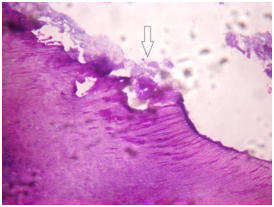
Stained sections showing less or no bacterial remnants after excavation with (a) Carisolv and (b) Papacarie
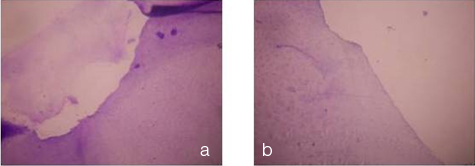
Comparison of dentinal tubule destruction in different groups
| Comparison between variables | YES n (%) | NO | TOTAL | Chi-square test p-value |
|---|
| Stainless Steel Bur | 24 (80) | 6 (20) | 30 (100) | 0.001 Significant |
| Polymer Bur | 6 (20) | 24 (80) | 30 (100) |
| Carisolv | 3 (10) | 27 (90) | 30 (100) |
| Papacarie | 3 (10) | 27 (90) | 30 (100) |
Statistical Analysis: Chi-square test. Statistically significant at p<0.05
Stained sections showing dentinal tubule destruction after excavation with stainless steel bur (arrow)
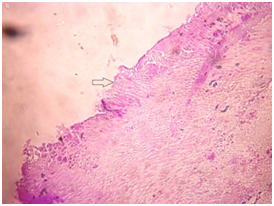
Stained sections showing dentinal tubule destruction after excavation with stainless steel bur (arrow)
| Comparison Variables | Mean Time Taken | Bacterial Deposits | Dentinal tubule destruction |
|---|
| Y | N | Total | Y | N | Total |
|---|
| Polymer Bur | 334.20 | 10 | 0 | 10 | 1 | 9 | 10 |
| Stainless Steel Bur | 135.00 | 1 | 9 | 10 | 7 | 3 | 10 |
| p-value | p*= 0.001 S* | p**= 0.001 S | p**= 0.020 S |
Statistical Analysis: Paired t-test. Statistically significant at p*<0.05
isher’s Exact-test. Statistically significant at p** <0.05. S*: Significant
Comparison of Time taken, Bacterial deposits and Dentinal Tubule Destruction after excavation with Polymer Bur and Carisolv
| Comparison Variables | Mean Time Taken | Bacterial Deposits | Dentinal tubule destruction |
|---|
| Y | N | Total | Y | N | Total |
|---|
| Polymer Bur | 334.80 | 9 | 1 | 10 | 2 | 8 | 10 |
| Carisolv | 465.60 | 4 | 6 | 10 | 1 | 9 | 10 |
| p-value | p*= 0.001 S* | p**= 0.057 NS** | p**= 1.00 NS |
Statistical Analysis: Paired t-test. Statistically significant at p*<0.05
Fisher’s Exact-test. Statistically significant at p** < 0.05. S*: Significant Not Significant
Comparison of Time taken, Bacterial deposits and Dentinal Tubule Destruction after excavation with Polymer Bur and Papacarie
| Comparison Variables | Mean Time Taken | Bacterial Deposits | Dentinal tubule destruction |
|---|
| Y | N | Total | Y | N | Total |
|---|
| Polymer Bur | 365.40 | 10 | 0 | 10 | 3 | 7 | 10 |
| Papacarie | 362.60 | 0 | 10 | 10 | 1 | 9 | 10 |
| p-value | p*= 0.856 NS** | p**= 0.001 S* | p**= 0.582 NS |
Statistical Analysis: Paired t-test. Statistically significant at p*<0.05
Fisher’s Exact-test. Statistically significant at p** <0.05. S*: Significant Not Significant
Comparison of Time taken, Bacterial deposits and Dentinal Tubule Destruction after excavation with Stainless Steel Bur and Carisolv
| Comparison Variables | Mean Time Taken | Bacterial Deposits | Dentinal tubule destruction |
|---|
| Y | N | Total | Y | N | Total |
|---|
| Stainless Steel Bur | 155.40 | 1 | 9 | 10 | 8 | 2 | 10 |
| Carisolv | 451.40 | 4 | 6 | 10 | 0 | 10 | 10 |
| p-value | p*= 0.001 S* | p**= 0.303 NS** | p**= 0.001 S |
Statistical Analysis: Paired t-test. Statistically significant at p*<0.05
Fisher’s Exact-test. Statistically significant at p**<0.05. S*: Significant Not Significant
Comparison of time taken, bacterial deposits and dentinal tubule destruction after excavation with stainless steel bur and papacarie
| Comparison Variables | Mean Time Taken | Bacterial Deposits | Dentinal tubule destruction |
|---|
| Y | N | Total | Y | N | Total |
|---|
| Stainless Steel Bur | 162.60 | 1 | 9 | 10 | 9 | 1 | 10 |
| Papacarie | 357.80 | 5 | 5 | 10 | 1 | 9 | 10 |
| p-value | p*= 0.001 S* | p**= 0.141 NS** | p**= 0.001S |
Statistical Analysis: Paired t-test. Statistically significant at p*<0.05
Fisher’s Exact-test. Statistically significant at p**<0.05. S*: Significant Not Significant
Comparison of time taken, bacterial deposits and dentinal tubule destruction after excavation with papacarie and carisolv
| Comparison Variables | Mean Time Taken | Bacterial Deposits | Dentinal tubule destruction |
|---|
| Y | N | Total | Y | N | Total |
|---|
| Papacarie | 358.40 | 2 | 8 | 10 | 1 | 9 | 10 |
| Carisolv | 467.80 | 5 | 5 | 10 | 2 | 8 | 10 |
| p-value | p*= 0.001 S* | p**= 0.350 NS** | p**= 1.00 NS |
Statistical Analysis: Paired t-test. Statistically significant at p*<0.05
Fisher’s Exact-test. Statistically significant at p**<0.05. S*: Significant Not Significant
Conclusion
Among the four agents (Stainless Steel Bur, Polymer Bur, Papacarie, Carisolv) following conclusions were drawn from the study-
1. The mean time taken for caries removal was found to be more for Carisolv when compared to others.
2. More amount of Bacterial remnants were present after excavation with Polymer Bur.
3. Excavation with Polymer Bur, Carisolv, Papacarie is more conservative with the least amount of Dentinal tubule destruction when compared to Stainless Steel Bur.
Statistical Analysis: Chi-square test. Statistically significant at p<0.05
Statistical Analysis: Chi-square test. Statistically significant at p<0.05
Statistical Analysis: Paired t-test. Statistically significant at p*<0.05isher’s Exact-test. Statistically significant at p** <0.05. S*: Significant
Statistical Analysis: Paired t-test. Statistically significant at p*<0.05Fisher’s Exact-test. Statistically significant at p** < 0.05. S*: Significant Not Significant
Statistical Analysis: Paired t-test. Statistically significant at p*<0.05Fisher’s Exact-test. Statistically significant at p** <0.05. S*: Significant Not Significant
Statistical Analysis: Paired t-test. Statistically significant at p*<0.05Fisher’s Exact-test. Statistically significant at p**<0.05. S*: Significant Not Significant
Statistical Analysis: Paired t-test. Statistically significant at p*<0.05Fisher’s Exact-test. Statistically significant at p**<0.05. S*: Significant Not Significant
Statistical Analysis: Paired t-test. Statistically significant at p*<0.05Fisher’s Exact-test. Statistically significant at p**<0.05. S*: Significant Not Significant
[1]. LJ Motta, MD Martins, KP Porta, SK Bussadori, Aesthetic restoration of deciduous anterior teeth after removal of carious tissue with PapacarieIndian J Dent Res 2009 20:117-20. [Google Scholar]
[2]. DS Alleman, P Magne, A Systematic approach to deep caries removal end points: The peripheral seal concept in adhesive dentistryQuintessence Int 2012 43:197-208. [Google Scholar]
[3]. J Sankar, V Shivanna, DNM Kumar, Efficacy of Chemomechanical Method (Carisolv) of caries removal with that of hand cutting and rotary cutting instrumentsAnnals and Essences of Dentistry 2011 3:27-31. [Google Scholar]
[4]. NR Elkholany, KM Abdelaziz, NM Zaghloul, N Abdolenine, Chemomechanical method: A valuable alternative for caries removal Journal Of Minimal Intervention In Dentistry 2009 2:248-60. [Google Scholar]
[5]. P Celibreti, P Francescut, A Lussi, Performance of Four Dentine Excavation Methods in Deciduous TeethCaries Res 2008 40:117-23. [Google Scholar]
[6]. FNP Correa, RO Rocha, LER Filho, A Muench, CRMD Rodrigues, Chemical Versus Conventional Caries Removal Techniques in Primary Teeth: A Microhardness StudyJ Clin Paediatr Dent 2007 31:189-94. [Google Scholar]
[7]. C Meller, A Welk, T Zeligowski, C Splieth, Comparison of dentin caries excavation with polymer and conventional tungsten carbide bursQuintesssence Int 2007 38:565-69. [Google Scholar]
[8]. VS Pai, RR Nadig, TG Jagadeesh, G Usha, J Karthik, KS Sridhara, Chemical Analysis of Dentin Surfaces after Carisolv treatmentJ Conserv Dent 2009 12:118-22. [Google Scholar]
[9]. SK Bussadori, LC Castro, AC Galvao, Papain Gel: A New Chemo-Mechanical Caries Removal AgentJ Clin Paediatr Dent 2005 30:115-20. [Google Scholar]
[10]. CM Carillo, MH Tanaka, MF Cesar, MAF Camargo, Y Juliano, NF Novo, Use of Papain Gel in Disabled PatientsJ Dent Child 2008 75:222-28. [Google Scholar]
[11]. CC Miller, F Decup, SD Orliaguet, D Gillet, M Guigand, R Kaleka, Clinical evaluation of the carisolv chemo-mechanical caries removal technique according to the site/stage concept, a revised caries classification systemClinc Oral Invest 2003 7:32-37. [Google Scholar]
[12]. AAD Neves, E Coutinho, MV Cardos, P Lambrechts, BV Meerbeek, Current Concepts and Techniques for Caries Excavation and Adhesion to Residual DentinJ Adhes Dent 2011 13:7-22. [Google Scholar]
[13]. AR Genot, T Kaur, N Basappa, Comparative Evaluation of Carisolv in Removal of Carious Dentin in Primary Molar Teeth: in vitro StudyPesq Bras Odontoped Clin Integr, Joao Pessoa 2009 9:77-80. [Google Scholar]
[14]. NRC Luedemann, AND Ilie, R Hickel, KH Kunzelmann, Micro-computed Tomographic Evaluation of a New Enzyme Solution for Caries Removal in Deciduous TeethDent Mater J. 2006 25:675-83. [Google Scholar]
[15]. J Sankar, V Shivanna, DNM Kumar, Efficacy of chemomechanical method (carisolv) of caries removal with that of hand cutting and rotary cutting instrumentsAnnals and Essences of Dentistry. 2011 3:27-31. [Google Scholar]
[16]. D Jawa, S Singh, R Somani, S Jaidka, K Srikar, R Jaidka, comparative evaluation of the efficacy of chemomechanical caries removal agent (Papacarie) andconventional method of caries removal: An invitro studyJ Indian Soc Pedod Prev Dent 2010 :73-77. [Google Scholar]
[17]. E Piva, FA Ogliari, RR Moraes, F Cora, S Henn, LC Sobrinho, Papain based gel for biochemical caries removal:influence on microtensile bond strength to dentin Braz Oral Res 2008 22:364-70. [Google Scholar]
[18]. K Sanjai, J Kumarswamy, A Patil, L Papaiah, S Jayaram, L Krisshnan, Evaluation and comparison of decalcification agents on the human teeth.Journal of Oral and Maxillofacial Pathology. 2012 16:222-27. [Google Scholar]
[19]. T Dammaschke, TN Rodenberg, E Schafer, KHR Ott, Efficiency of the Polymer Bur SmartPrep Compared with Conventional Tungsten Carbide Bud Bur in Dentin Caries ExcavationOper Dent 2006 31:256-60. [Google Scholar]
[20]. I Balciuniene, R Sabalaite, I Juskiene, Chemomechanical Caries Removal for ChildrenStomatologija, Baltic Dental and Maxillofacial Journal. 2005 74:40-44. [Google Scholar]
[21]. AM Hegde, VC Preethi, A Shetty, S Shetty, Clinical Evaluation of Chemomechanical caries removal using Carie-Care system among school childrenNUHS 2014 4(3):80-84. [Google Scholar]
[22]. ME Tekeya, LE Habashy, N Mokhles, EE Kimray, Effectiveness of 2 Chemomechanical Caries Removal Methods on Residual Bacteria in Dentin of Primary TeethPaediatr Dent 2012 34:325-30. [Google Scholar]